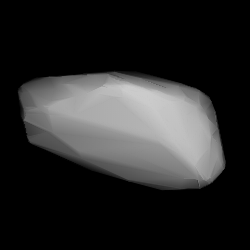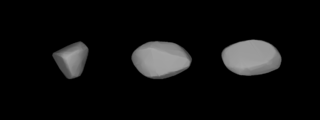Related Research Articles
2127 Tanya, provisional designation 1971 KB1, is a carbonaceous asteroid from the outer region of the asteroid belt, approximately 40 kilometers in diameter. It was discovered on 29 May 1971, by Russian astronomer Lyudmila Chernykh at the Crimean Astrophysical Observatory in Nauchnij, on the Crimean peninsula. It was named in memory of Tanya Savicheva, a Russian child diarist during World War II.
1024 Hale, provisional designation A923 YO13, is a carbonaceous background asteroid from the outer regions of the asteroid belt, approximately 45 kilometers (28 miles) in diameter. The asteroid was discovered on 2 December 1923, by Belgian–American astronomer George Van Biesbroeck at the Yerkes Observatory in Wisconsin, United States. It was named for American astronomer George Ellery Hale. The dark C-type asteroid may have a rotation period of 16 hours.
1027 Aesculapia, provisional designation A923 YO11, is a Themistian asteroid from the outer region of the asteroid belt, approximately 33 kilometers in diameter.
1070 Tunica, provisional designation 1926 RB, is a dark background asteroid from the outer regions of the asteroid belt, approximately 35 kilometers in diameter. It was discovered on 1 September 1926, by German astronomer Karl Reinmuth at the Heidelberg-Königstuhl State Observatory in southwest Germany. The asteroid was named after Petrorhagia, a flowering plant also known as "Tunica".
6349 Acapulco, provisional designation 1995 CN1, is a dark Adeonian asteroid from the middle region of the asteroid belt, approximately 22 kilometers in diameter.
3067 Akhmatova, provisional designation 1982 TE2, is a stony Flora asteroid from the inner regions of the asteroid belt, approximately 6 kilometers in diameter.

10656 Albrecht is a carbonaceous background asteroid from the outer region of the asteroid belt, approximately 10 kilometers in diameter. It was named after German astronomer Carl Theodor Albrecht.
4936 Butakov, provisional designation 1985 UY4, is a stony Florian asteroid from the inner regions of the asteroid belt, approximately 5 kilometers in diameter. The asteroid was discovered on 22 October 1985, by Soviet–Ukrainian astronomer Lyudmila Zhuravleva at the Crimean Astrophysical Observatory in Nauchnyj, on the Crimean peninsula. It was named after Russian admiral Grigory Butakov.
1253 Frisia, provisional designation 1931 TV1, is a carbonaceous Themistian asteroid from the outer regions of the asteroid belt, approximately 20 kilometers in diameter. Discovered by Karl Reinmuth at Heidelberg Observatory in 1931, the asteroid was later named after the region of Frisia and the Frisian Islands.
14789 GAISh, provisional designation 1969 TY1, is a dark background asteroid from the outer regions of the asteroid belt, approximately 15 kilometers (9 miles) in diameter. It was discovered on 8 October 1969, by Soviet astronomer Lyudmila Chernykh of the Crimean Astrophysical Observatory at Nauchnij, on the Crimean peninsula. The assumed C-type asteroid has a rotation period of 8.1 hours and possibly an elongated shape. It was named for the Russian Sternberg Astronomical Institute (GAISh) of Moscow State University.

1337 Gerarda, provisional designation 1934 RA1, is a dark background asteroid from the outer regions of the asteroid belt, approximately 40 kilometers in diameter. It was discovered on 9 September 1934, by Dutch astronomer Hendrik van Gent at the Union Observatory in Johannesburg, South Africa. The asteroid was named after Gerarda Prins, the wife of an orbit computer at Leiden Observatory.

6546 Kaye (prov. designation: 1987 DY4) is a dark and elongated background asteroid from the outer region of the asteroid belt. It was discovered on 24 February 1987, by Czech astronomer Antonín Mrkos at the South Bohemian Kleť Observatory in the Czech Republic. The presumed C-type asteroid has a rotation period of 10.0 hours and measures approximately 22 kilometers (14 miles) in diameter. It was named for American actor Danny Kaye.

1930 Lucifer, provisional designation 1964 UA, is a carbonaceous asteroid from the outer regions of the asteroid belt, approximately 34 kilometers in diameter. It was discovered on 29 October 1964, by American astronomer Elizabeth Roemer at the Flagstaff station (NOFS) of the United States Naval Observatory (USNO). It is named after Lucifer, the "shining one" or "light-bearer" from the Hebrew Bible.
7476 Ogilsbie, provisional designation 1993 GE, is a carbonaceous asteroid from the outer region of the asteroid belt, approximately 20 kilometers in diameter. It was discovered by American astronomer Timothy Spahr at the U.S. Catalina Station in Tucson, Arizona, on 14 April 1993.

1436 Salonta, provisional designation 1936 YA, is a dark background asteroid from the outer regions of the asteroid belt, approximately 60 kilometers in diameter. Discovered by György Kulin at the Konkoly Observatory in 1936, the asteroid was later named for the Romanian city of Salonta, the birthplace of the discoverer.
4003 Schumann, provisional designation 1964 ED, is a carbonaceous asteroid from the outer region of the asteroid belt, approximately 35 kilometers in diameter.
1625 The NORC is a carbonaceous asteroid from the outer region of the asteroid belt, approximately 55 kilometers in diameter. It was discovered on 1 September 1953, by Belgian astronomer Sylvain Arend at the Royal Observatory of Belgium in Uccle, Belgium. It was named after the IBM Naval Ordnance Research Calculator (NORC).
2104 Toronto, provisional designation 1963 PD, is a metallic background asteroid from the outer regions of the asteroid belt, approximately 36 kilometers in diameter. It was discovered on 15 August 1963, by Karl Kamper at the David Dunlap Observatory on plates taken by Sidney van den Bergh at the Karl Schwarzschild Observatory in Tautenburg, Germany. The asteroid was named after the University of Toronto. It was the first asteroid discovered at an observatory in Canada.
1684 Iguassú, provisional designation 1951 QE, is a carbonaceous asteroid from the outer region of the asteroid belt, approximately 30.5 kilometers in diameter. It was discovered on 23 August 1951, by Argentine astronomer Miguel Itzigsohn at the La Plata Astronomical Observatory, located in the city of La Plata, Argentina. It was named after the Iguazu Falls in South America.
1844 Susilva, provisional designation 1972 UB, is a stony Eoan asteroid from the outer region of the asteroid belt, approximately 22 kilometers in diameter. It was discovered on 30 October 1972, by Swiss astronomer Paul Wild at Zimmerwald Observatory near Bern, Switzerland, and later named after a schoolfriend of the discoverer.
References
- 1 2 3 4 "JPL Small-Body Database Browser: 1845 Helewalda (1972 UC)" (2017-05-05 last obs.). Jet Propulsion Laboratory . Retrieved 8 June 2017.
- 1 2 3 Schmadel, Lutz D. (2007). "(1845) Helewalda". Dictionary of Minor Planet Names. Springer Berlin Heidelberg. p. 148. doi:10.1007/978-3-540-29925-7_1846. ISBN 978-3-540-00238-3.
- 1 2 3 4 5 6 7 "LCDB Data for (1845) Helewalda". Asteroid Lightcurve Database (LCDB). Retrieved 18 May 2016.
- 1 2 "Asteroid 1845 Helewalda – Nesvorny HCM Asteroid Families V3.0". Small Bodies Data Ferret. Retrieved 26 October 2019.
- 1 2 3 Masiero, Joseph R.; Grav, T.; Mainzer, A. K.; Nugent, C. R.; Bauer, J. M.; Stevenson, R.; et al. (August 2014). "Main-belt Asteroids with WISE/NEOWISE: Near-infrared Albedos". The Astrophysical Journal. 791 (2): 11. arXiv: 1406.6645 . Bibcode:2014ApJ...791..121M. doi:10.1088/0004-637X/791/2/121 . Retrieved 8 December 2016.
- 1 2 3 4 Mainzer, A.; Grav, T.; Masiero, J.; Hand, E.; Bauer, J.; Tholen, D.; et al. (November 2011). "NEOWISE Studies of Spectrophotometrically Classified Asteroids: Preliminary Results". The Astrophysical Journal. 741 (2): 25. arXiv: 1109.6407 . Bibcode:2011ApJ...741...90M. doi:10.1088/0004-637X/741/2/90 . Retrieved 18 May 2016.
- 1 2 Behrend, Raoul. "Asteroids and comets rotation curves – (1845) Helewalda". Geneva Observatory . Retrieved 18 May 2016.
- 1 2 3 Waszczak, Adam; Chang, Chan-Kao; Ofek, Eran O.; Laher, Russ; Masci, Frank; Levitan, David; et al. (September 2015). "Asteroid Light Curves from the Palomar Transient Factory Survey: Rotation Periods and Phase Functions from Sparse Photometry". The Astronomical Journal. 150 (3): 35. arXiv: 1504.04041 . Bibcode:2015AJ....150...75W. doi:10.1088/0004-6256/150/3/75 . Retrieved 18 May 2016.
- 1 2 Carbo, Landry; Green, Dawson; Kragh, Katherine; Krotz, Jonathan; Meiers, Andrew; Patino, Bernadette; et al. (October 2009). "Asteroid Lightcurve Analysis at the Oakley Southern Sky Observatory: 2008 October thru 2009 March". The Minor Planet Bulletin. 36 (4): 152–157. Bibcode:2009MPBu...36..152C. ISSN 1052-8091 . Retrieved 18 May 2016.
- 1 2 Brinsfield, James W. (October 2010). "Asteroid Lightcurve Analysis at the Via Capote Observatory: 2010 February-May". The Minor Planet Bulletin. 37 (4): 146–147. Bibcode:2010MPBu...37..146B. ISSN 1052-8091 . Retrieved 18 May 2016.
- ↑ Veres, Peter; Jedicke, Robert; Fitzsimmons, Alan; Denneau, Larry; Granvik, Mikael; Bolin, Bryce; et al. (November 2015). "Absolute magnitudes and slope parameters for 250,000 asteroids observed by Pan-STARRS PS1 - Preliminary results". Icarus. 261: 34–47. arXiv: 1506.00762 . Bibcode:2015Icar..261...34V. doi:10.1016/j.icarus.2015.08.007 . Retrieved 18 May 2016.
- 1 2 "1845 Helewalda (1972 UC)". Minor Planet Center. Retrieved 18 May 2016.
- ↑ Nesvorný, D.; Broz, M.; Carruba, V. (December 2014). "Identification and Dynamical Properties of Asteroid Families". Asteroids IV. pp. 297–321. arXiv: 1502.01628 . Bibcode:2015aste.book..297N. doi:10.2458/azu_uapress_9780816532131-ch016. ISBN 9780816532131.
- ↑ "Himmlischer Besuch auf der Sternwarte Eschenberg" (in German). Sternwarte Eschenberg. Retrieved 1 March 2016.
Helen Gachnang and Susi Petit-Pierre visit the Eschenberg Observatory
- ↑ Schmadel, Lutz D. (2009). "Appendix – Publication Dates of the MPCs". Dictionary of Minor Planet Names – Addendum to Fifth Edition (2006–2008) . Springer Berlin Heidelberg. p. 221. doi:10.1007/978-3-642-01965-4. ISBN 978-3-642-01964-7.